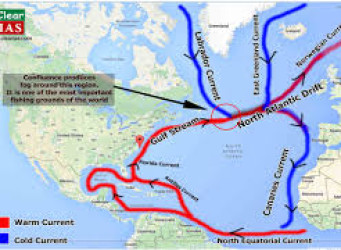
By Ishaan Tharoor
July 30,2019
We’re still coming to grips with how hot the recent heat wave that scorched through Europe actually was. On Monday, officials in Britain confirmed the country experienced its hottest day on record last Thursday. July 25 also broke national records in the Netherlands, Belgium and Germany. In Paris, the temperature reached 108.7 degrees Fahrenheit (42.6 Celsius), smashing the French capital’s 72-year-old record by a staggering four degrees. Over the weekend, records fell across Scandinavia, with the Norwegian Meteorological Institute even reporting that 20 places in southern Norway experienced “tropical nights.”
What happened? An intense area of high pressure, known as a “heat dome,” settled over Western Europe. As The Washington Post’s deputy weather editor Andrew Freedman explained, the stunning margins by which many of the previous record highs were eclipsed over the last week point to an inescapable reality: man-made climate change.
“Pending detailed analyses, climate scientists say it’s unlikely that this event would have occurred without the influence of human-caused global warming,” Freedman wrote in a memo to Today’s WorldView. “The weather system responsible for the heat wave is now parked on top of Greenland, where it is expected to significantly speed up the pace and extent of ice melt for the next week. It could also help to drive Arctic sea ice to a record low by September, beating a record set in 2012.”
Conditions are all the more terrifying elsewhere. Epic heat waves racked South Asia and the Middle East earlier this summer; glaciers in the Himalayas are now melting at double the rate since the turn of the century. Last month, the World Meteorological Organization projected that the period between the beginning of 2015 and the end of this year will mark the Earth’s five warmest years on record.
In an email to Freedman and his colleagues at The Post’s Capital Weather Gang, Radley Horton, a climate researcher at Columbia University, put it bluntly. “The verdict is in: Increasing greenhouse gas concentrations due to human activity — by raising average temperatures — have loaded the dice toward more frequent record breaking heat extremes,” wrote Horton. “But the magnitude with which all-time records are being broken . . . suggests an accomplice. Specifically, human-driven increases in the variability of our day-to-day weather.”
Last year, the U.N.’s Intergovernmental Panel on Climate Change decreed that the world would have to reduce total carbon emissions by 45 percent before 2030 if it hoped to prevent a rise in global temperatures below a likely ruinous 1.5 degrees Celsius by the end of the century. Now, experts and advocates insist the real action needs to happen by the end of next year.
“Current plans are nowhere near strong enough to keep temperatures below the so-called safe limit,” wrote BBC environment correspondent Matt McGrath. “Right now, we are heading towards 3 [degrees Celsius] of heating by 2100 not 1.5. As countries usually scope out their plans over five and 10 year time frames, if the 45 percent carbon cut target by 2030 is to be met then the plans really need to be on the table by the end of 2020.”
To that end, advocates point to a series of crucial international meetings: A major U.N. conference on climate action in New York this September and the COP25 climate change conference in Chile this December, which will build on previous rounds of international diplomacy, including the landmark 2016 Paris climate agreement. U.N. Secretary-General António Guterres has dubbed climate change “the battle of our lives” and has asked leaders attending the U.N. summit in September to come “ready to announce the plans that they will set next year to reduce greenhouse gas emissions for 2030 and to achieve net zero emissions by 2050.”
One prominent attendee will be Greta Thunberg, the 16-year-old Swedish climate activist who has captured the global imagination as an outspoken advocate for climate action. She will make the trip across the Atlantic aboard an emission-neutral high-speed yacht. Though she eschews jet travel for its high carbon footprint, Thunberg wrote on social media in June that she had to attend both conferences because, “this is pretty much where our future will be decided.
“As these things are happening, remember that there were probably multiple scientists like me who warned of these dangers but were silenced,”
wrote Maria Caffrey, a whistleblowing scientist in the administration who claims she lost her job at the National Park Service after calling out internal attempts to suppress climate science. “The current administration may only last a matter of years, but its actions may potentially impact our planet for centuries.”
For right-wing opponents or skeptics of the climate change crowd, the cost of bending to the scientific consensus is not worth it — either for their election chances or the bottom lines of the fossil fuel industries they favor. Climate change activists are exasperated with such short-termism. And even major fossil fuel companies pay more lip service to reckoning with climate change than Trump and his ilk.
“Either we radically transform human collective life by abandoning the use of fossil fuels or, more likely, climate change will bring about the end of global fossil-fueled capitalist civilization,” wrote Roy Scranton in an April essay in MIT Technology Review. “Revolution or collapse — in either case, the good life as we know it is no longer viable.”
Others are less doom-mongering, and believe a committed recalibration may stave off catastrophe. “There’s a time and a place for growth, and a time and a place for maturity, for balance, for scale,” wrote American environmentalist and author Bill McKibbenin his new book, “Falter.” “Perhaps our job, at this particular point in time, is to slow things down, just as basketball teams do when they’re ahead. If we don’t screw up the game of being human, it could last for a very long time; compared to other species, we’re still early in our career.”




